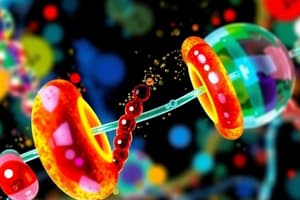Podcast
Questions and Answers
How the Hydrolysis of ATP Performs Work
When ATP is hydrolyzed in a test tube, the release of free energy merely heats the surrounding water. In an organism, this same generation of heat can sometimes be beneficial. For instance, the process of shivering uses ATP hydrolysis during muscle contraction to warm the body. In most cases in the cell, however, the generation of heat alone would be an inef- ficient (and potentially dangerous) use of a valuable energy resource. Instead, the cell’s proteins harness the energy released during ATP hydrolysis in several ways to perform the three types of cellular work—chemical, transport, and mechanical.
For example, with the help of specific enzymes, the cell is able to use the energy released by ATP hydrolysis directly to drive chemical reactions that, by themselves, are ender- gonic. If the ∆G of an endergonic reaction is less than the amount of energy released by ATP hydrolysis, then the two reactions can be coupled so that, overall, the coupled reac- tions are exergonic. This usually involves phosphorylation, the transfer of a phosphate group from ATP to some other molecule, such as the reactant. The recipient molecule with the phosphate group covalently bonded to it is then called a phosphorylated intermediate. The key to coupling exergonic and endergonic reactions is the forma- tion of this phosphorylated intermediate, which is more
Adenine NH2
NCCN O O O HC C CH
–OPOPOPO CH N N
O– O– O–
Triphosphate group (3 phosphate groups)
2O HH
(a) The structure of ATP. In the cell, most hydroxyl groups of phosphates are ionized (—O–).
H
H Ribose
OH OH
PPP
Adenosine triphosphate (ATP)
H2O
P P
Adenosine diphosphate (ADP)
- Pi + Energy Inorganic
phosphate
(b) The hydrolysis of ATP. The reaction of ATP and water yields ADP and inorganic phosphate ( P i ) and releases energy.
Animation: The Structure of ATP Animation: Space-Filling Model of ATP Animation: Stick Model of ATP
chApter 8 An Introduction to Metabolism 151
Figure 8.10 how Atp drives chemical work: energy coupling using Atp hydrolysis. In this example, the exergonic process of ATP hydrolysis is used to drive an endergonic process—the cellular synthesis of the amino acid glutamine from glutamic acid and ammonia.
(a) Glutamic acid conversion to glutamine.
Glutamine synthesis from glutamic acid (Glu) by itself is endergonic (ΔG is positive), so it is not spontaneous.
NH NH Glu + 3 Glu
ΔGGlu = +3.4 kcal/mol
Glutamic acid Ammonia
2 Glutamine
(b) Conversion reaction coupled with ATP hydrolysis. In the cell, glutamine synthesis occurs in two steps, coupled by a phosphorylated intermediate. 1 ATP phosphorylates glutamic acid, making it less stable, with more free energy.
2 Ammoniadisplacesthephosphategroup, forming glutamine.
1
P
NH3
- ADP
2
NH Glutamine
- ATP Glutamic acid
Glu
Glu
2 + ADP + P i
Glu
Phosphorylated intermediate
(c) Free-energy change for coupled reaction. ΔG for the glutamic acid conversion to glutamine (+3.4 kcal/mol) plus ΔG for ATP hydrolysis (–7.3 kcal/mol) gives the free-energy change for the overall reaction (–3.9 kcal/mol). Because the overall process is exergonic (net ΔG is negative), it occurs spontaneously.
ΔGGlu = +3.4 kcal/mol 3 + ATP
ΔG ATP
Glu +
NH
NH
2 + ADP + P i = –7.3 kcal/mol
Glu
ΔGGlu = +3.4 kcal/mol + ΔGATP = –7.3 kcal/mol
Net ΔG = –3.9 kcal/mol
MAKe ConneCtIons Referring to Figure 5.14, explain why glutamine (Gln) is diagrammed as a glutamic acid (Glu) with an amino group attached.
reactive (less stable, with more free energy) than the original unphosphorylated molecule (Figure 8.10).
Transport and mechanical work in the cell are also nearly always powered by the hydrolysis of ATP. In these cases, ATP hydrolysis leads to a change in a protein’s shape and often its ability to bind another molecule. Sometimes this occurs via a phosphorylated intermediate, as seen for the transport protein in Figure 8.11a. In most instances of mechanical work involving motor proteins “walking” along cytoskeletal
elements (Figure 8.11b), a cycle occurs in which ATP is first bound noncovalently to the motor protein. Next, ATP is hydrolyzed, releasing ADP and ~P i. Another ATP molecule can then bind. At each stage, the motor protein changes
its shape and ability to bind the cytoskeleton, resulting
in movement of the protein along the cytoskeletal track. Phosphorylation and dephosphorylation promote crucial protein shape changes during many other important cellu- lar processes as well.
Figure 8.11 how Atp drives transport and mechanical work. ATP hydrolysis causes changes in the shapes and binding affinities of proteins. This can occur either (a) directly, by phosphorylation, as shown for a membrane protein carrying out active transport of a solute (see also Figure 7.15), or (b) indirectly, via noncovalent binding of ATP and its hydrolytic products, as is the case for motor proteins that move vesicles (and other organelles) along cytoskeletal “tracks” in the cell (see also Figure 6.21).
ATP
Transport protein Solute
PPi Solute transported
ADP + P i
(a) Transport work: ATP phosphorylates transport proteins, causing a shape change that allows transport of solutes.
Vesicle
ATP ATP Motor protein
Cytoskeletal track
Protein and vesicle moved
ADP +
P i
(b) Mechanical work: ATP binds noncovalently to motor proteins and then is hydrolyzed, causing a shape change that walks the motor protein forward.
152 Unit tWo The Cell
Figure 8.12 the Atp cycle. Energy released by breakdown reactions (catabolism) in the cell is used to phosphorylate ADP, regenerating ATP. Chemical potential energy stored in ATP drives most cellular work.
Animation: Metabolism Overview
How the Hydrolysis of ATP Performs Work When ATP is hydrolyzed in a test tube, the release of free energy merely heats the surrounding water. In an organism, this same generation of heat can sometimes be beneficial. For instance, the process of shivering uses ATP hydrolysis during muscle contraction to warm the body. In most cases in the cell, however, the generation of heat alone would be an inef- ficient (and potentially dangerous) use of a valuable energy resource. Instead, the cell’s proteins harness the energy released during ATP hydrolysis in several ways to perform the three types of cellular work—chemical, transport, and mechanical. For example, with the help of specific enzymes, the cell is able to use the energy released by ATP hydrolysis directly to drive chemical reactions that, by themselves, are ender- gonic. If the ∆G of an endergonic reaction is less than the amount of energy released by ATP hydrolysis, then the two reactions can be coupled so that, overall, the coupled reac- tions are exergonic. This usually involves phosphorylation, the transfer of a phosphate group from ATP to some other molecule, such as the reactant. The recipient molecule with the phosphate group covalently bonded to it is then called a phosphorylated intermediate. The key to coupling exergonic and endergonic reactions is the forma- tion of this phosphorylated intermediate, which is more
Adenine NH2 NCCN O O O HC C CH –OPOPOPO CH N N O– O– O– Triphosphate group (3 phosphate groups) 2O HH (a) The structure of ATP. In the cell, most hydroxyl groups of phosphates are ionized (—O–). H H Ribose OH OH PPP Adenosine triphosphate (ATP) H2O P P Adenosine diphosphate (ADP)
- Pi + Energy Inorganic phosphate (b) The hydrolysis of ATP. The reaction of ATP and water yields ADP and inorganic phosphate ( P i ) and releases energy. Animation: The Structure of ATP Animation: Space-Filling Model of ATP Animation: Stick Model of ATP chApter 8 An Introduction to Metabolism 151 Figure 8.10 how Atp drives chemical work: energy coupling using Atp hydrolysis. In this example, the exergonic process of ATP hydrolysis is used to drive an endergonic process—the cellular synthesis of the amino acid glutamine from glutamic acid and ammonia. (a) Glutamic acid conversion to glutamine. Glutamine synthesis from glutamic acid (Glu) by itself is endergonic (ΔG is positive), so it is not spontaneous. NH NH Glu + 3 Glu ΔGGlu = +3.4 kcal/mol Glutamic acid Ammonia 2 Glutamine (b) Conversion reaction coupled with ATP hydrolysis. In the cell, glutamine synthesis occurs in two steps, coupled by a phosphorylated intermediate. 1 ATP phosphorylates glutamic acid, making it less stable, with more free energy. 2 Ammoniadisplacesthephosphategroup, forming glutamine. 1 P NH3
- ADP 2 NH Glutamine
- ATP Glutamic acid Glu Glu 2 + ADP + P i Glu Phosphorylated intermediate (c) Free-energy change for coupled reaction. ΔG for the glutamic acid conversion to glutamine (+3.4 kcal/mol) plus ΔG for ATP hydrolysis (–7.3 kcal/mol) gives the free-energy change for the overall reaction (–3.9 kcal/mol). Because the overall process is exergonic (net ΔG is negative), it occurs spontaneously. ΔGGlu = +3.4 kcal/mol 3 + ATP ΔG ATP Glu + NH NH 2 + ADP + P i = –7.3 kcal/mol Glu ΔGGlu = +3.4 kcal/mol + ΔGATP = –7.3 kcal/mol Net ΔG = –3.9 kcal/mol MAKe ConneCtIons Referring to Figure 5.14, explain why glutamine (Gln) is diagrammed as a glutamic acid (Glu) with an amino group attached. reactive (less stable, with more free energy) than the original unphosphorylated molecule (Figure 8.10). Transport and mechanical work in the cell are also nearly always powered by the hydrolysis of ATP. In these cases, ATP hydrolysis leads to a change in a protein’s shape and often its ability to bind another molecule. Sometimes this occurs via a phosphorylated intermediate, as seen for the transport protein in Figure 8.11a. In most instances of mechanical work involving motor proteins “walking” along cytoskeletal elements (Figure 8.11b), a cycle occurs in which ATP is first bound noncovalently to the motor protein. Next, ATP is hydrolyzed, releasing ADP and ~P i. Another ATP molecule can then bind. At each stage, the motor protein changes its shape and ability to bind the cytoskeleton, resulting in movement of the protein along the cytoskeletal track. Phosphorylation and dephosphorylation promote crucial protein shape changes during many other important cellu- lar processes as well. Figure 8.11 how Atp drives transport and mechanical work. ATP hydrolysis causes changes in the shapes and binding affinities of proteins. This can occur either (a) directly, by phosphorylation, as shown for a membrane protein carrying out active transport of a solute (see also Figure 7.15), or (b) indirectly, via noncovalent binding of ATP and its hydrolytic products, as is the case for motor proteins that move vesicles (and other organelles) along cytoskeletal “tracks” in the cell (see also Figure 6.21). ATP Transport protein Solute PPi Solute transported ADP + P i (a) Transport work: ATP phosphorylates transport proteins, causing a shape change that allows transport of solutes. Vesicle ATP ATP Motor protein Cytoskeletal track Protein and vesicle moved ADP + P i (b) Mechanical work: ATP binds noncovalently to motor proteins and then is hydrolyzed, causing a shape change that walks the motor protein forward. 152 Unit tWo The Cell
Figure 8.12 the Atp cycle. Energy released by breakdown reactions (catabolism) in the cell is used to phosphorylate ADP, regenerating ATP. Chemical potential energy stored in ATP drives most cellular work. Animation: Metabolism Overview
Flashcards are hidden until you start studying



